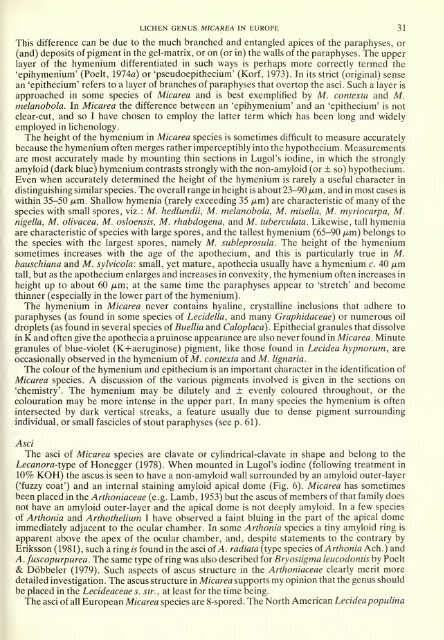Bulletin of the British Museum (Natural History)
Bulletin of the British Museum (Natural History)
Bulletin of the British Museum (Natural History)
You also want an ePaper? Increase the reach of your titles
YUMPU automatically turns print PDFs into web optimized ePapers that Google loves.
LICHEN GENUS MICAREA IN EUROPE 31<br />
This difference can be due to <strong>the</strong> much branched and entangled apices <strong>of</strong> <strong>the</strong> paraphyses, or<br />
(and) deposits <strong>of</strong> pigment in <strong>the</strong> gel-matrix, or on (or in) <strong>the</strong> walls <strong>of</strong> <strong>the</strong> paraphyses. The upper<br />
layer <strong>of</strong> <strong>the</strong> hymenium differentiated in such ways is perhaps more correctly termed <strong>the</strong><br />
'epihymenium' (Poelt, 1974a) or 'pseudoepi<strong>the</strong>cium' (Korf, 1973). In its strict (original) sense<br />
an 'epi<strong>the</strong>cium' refers to a layer <strong>of</strong> branches <strong>of</strong> paraphyses that overtop <strong>the</strong> asci. Such a layer is<br />
approached in some species <strong>of</strong> Micarea and is best exemplified by M. contexta and M.<br />
melanobola. In Micarea <strong>the</strong> difference between an 'epihymenium' and an 'epi<strong>the</strong>cium' is not<br />
clear-cut, and so I have chosen to employ <strong>the</strong> latter term which has been long and widely<br />
employed in lichenology.<br />
The height <strong>of</strong> <strong>the</strong> hymenium in Micarea species is sometimes difficult to measure accurately<br />
because <strong>the</strong> hymenium <strong>of</strong>ten merges ra<strong>the</strong>r imperceptibly into <strong>the</strong> hypo<strong>the</strong>cium. Measurements<br />
are most accurately made by mounting thin sections in Lugol's iodine, in which <strong>the</strong> strongly<br />
amyloid (dark blue) hymenium contrasts strongly with <strong>the</strong> non-amyloid (or ± so) hypo<strong>the</strong>cium.<br />
Even when accurately determined <strong>the</strong> height <strong>of</strong> <strong>the</strong> hymenium is rarely a useful character in<br />
distinguishing similar species. The overall range in height is about 23-90 /am, and in most cases is<br />
within 35-50 /xm. Shallow hymenia (rarely exceeding 35 /am) are characteristic <strong>of</strong> many <strong>of</strong> <strong>the</strong><br />
species with small spores, viz.: M. hedlundii, M. melanobola, M. misella, M. myriocarpa, M.<br />
nigella, M. olivacea, M. osloensis, M. rhabdogena, and M. tuberculata. Likewise, tall hymenia<br />
are characteristic <strong>of</strong> species with large spores, and <strong>the</strong> tallest hymenium (65-90 /u,m) belongs to<br />
<strong>the</strong> species with <strong>the</strong> largest spores, namely M. subleprosula. The height <strong>of</strong> <strong>the</strong> hymenium<br />
sometimes increases with <strong>the</strong> age <strong>of</strong> <strong>the</strong> apo<strong>the</strong>cium, and this is particularly true in M.<br />
bauschiana and M. sylvicola: small, yet mature, apo<strong>the</strong>cia usually have a hymenium c. 40 /zm<br />
tall, but as <strong>the</strong> apo<strong>the</strong>cium enlarges and increases in convexity, <strong>the</strong> hymenium <strong>of</strong>ten increases in<br />
height up to about 60 /xm; at <strong>the</strong> same time <strong>the</strong> paraphyses appear to 'stretch' and become<br />
thinner (especially in <strong>the</strong> lower part <strong>of</strong> <strong>the</strong> hymenium).<br />
The hymenium in Micarea never contains hyaline, crystalline inclusions that adhere to<br />
paraphyses (as found in some species <strong>of</strong> Lecidella, and many Graphidaceae) or numerous oil<br />
droplets (as found in several species <strong>of</strong> Buellia and Caloplaca). Epi<strong>the</strong>cial granules that dissolve<br />
in K and <strong>of</strong>ten give <strong>the</strong> apo<strong>the</strong>cia a pruinose appearance are also never found in Micarea. Minute<br />
granules <strong>of</strong> blue-violet (K+aeruginose) pigment, like those found in Lecidea hypnorum, are<br />
occasionally observed in <strong>the</strong> hymenium <strong>of</strong> M. contexta and M. lignaria.<br />
The colour <strong>of</strong> <strong>the</strong> hymenium and epi<strong>the</strong>cium is an important character in <strong>the</strong> identification <strong>of</strong><br />
Micarea species. A discussion <strong>of</strong> <strong>the</strong> various pigments involved is given in <strong>the</strong> sections on<br />
'chemistry'. The hymenium may be dilutely and ± evenly coloured throughout, or <strong>the</strong><br />
colouration may be more intense in <strong>the</strong> upper part. In many species <strong>the</strong> hymenium is <strong>of</strong>ten<br />
intersected by dark vertical streaks, a feature usually due to dense pigment surrounding<br />
individual, or small fascicles <strong>of</strong> stout paraphyses (see p. 61).<br />
Asci<br />
The asci <strong>of</strong> Micarea species are clavate or cylindrical-clavate in shape and belong to <strong>the</strong><br />
Lecanora-type <strong>of</strong> Honegger (1978). When mounted in Lugol's iodine (following treatment in<br />
10% KOH) <strong>the</strong> ascus is seen to have a non-amyloid wall surrounded by an amyloid outer-layer<br />
('fuzzy coat') and an internal staining amyloid apical dome (Fig. 6). Micarea has sometimes<br />
been placed in <strong>the</strong> Arthoniaceae (e.g. Lamb, 1953) but <strong>the</strong> ascus <strong>of</strong> members <strong>of</strong> that family does<br />
not have an amyloid outer-layer and <strong>the</strong> apical dome is not deeply amyloid. In a few species<br />
<strong>of</strong> Arthonia and Artho<strong>the</strong>lium I have observed a faint bluing in <strong>the</strong> part <strong>of</strong> <strong>the</strong> apical dome<br />
immediately adjacent to <strong>the</strong> ocular chamber. In some Arthonia species a tiny amyloid ring is<br />
apparent above <strong>the</strong> apex <strong>of</strong> <strong>the</strong> ocular chamber, and, despite statements to <strong>the</strong> contrary by<br />
Eriksson (1981), such a ring is found in <strong>the</strong> asci <strong>of</strong> ^. radiata (type species oi Arthonia Ach.) and<br />
A. fuscopurpurea. The same type <strong>of</strong> ring was also described for Bryostigma leucodontis by Poelt<br />
& Dobbeler (1979). Such aspects <strong>of</strong> ascus structure in <strong>the</strong> Arthoniaceae clearly merit more<br />
detailed investigation. The ascus structure in Micarea supports my opinion that <strong>the</strong> genus should<br />
be placed in <strong>the</strong> Lecideaceaes. str., at least for <strong>the</strong> time being.<br />
The asci <strong>of</strong> all European Micarea species are 8-spored. The North American Lecidea populina

















